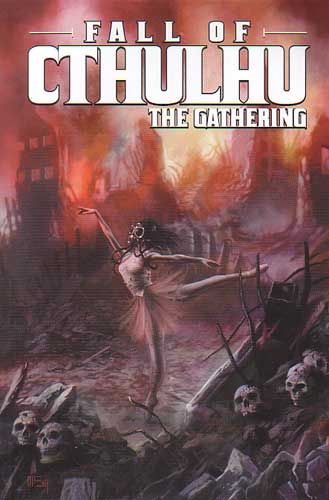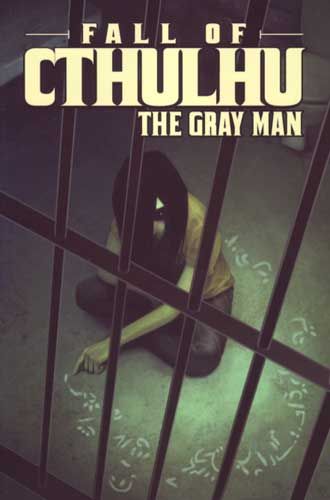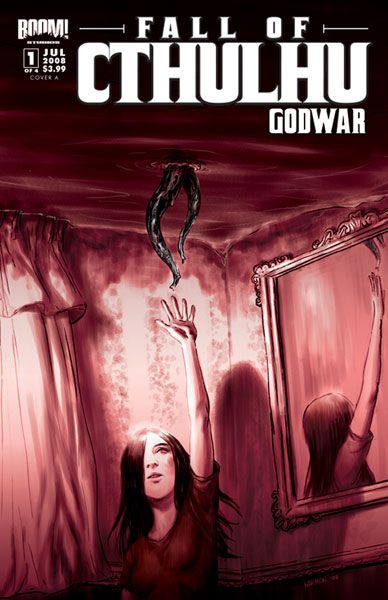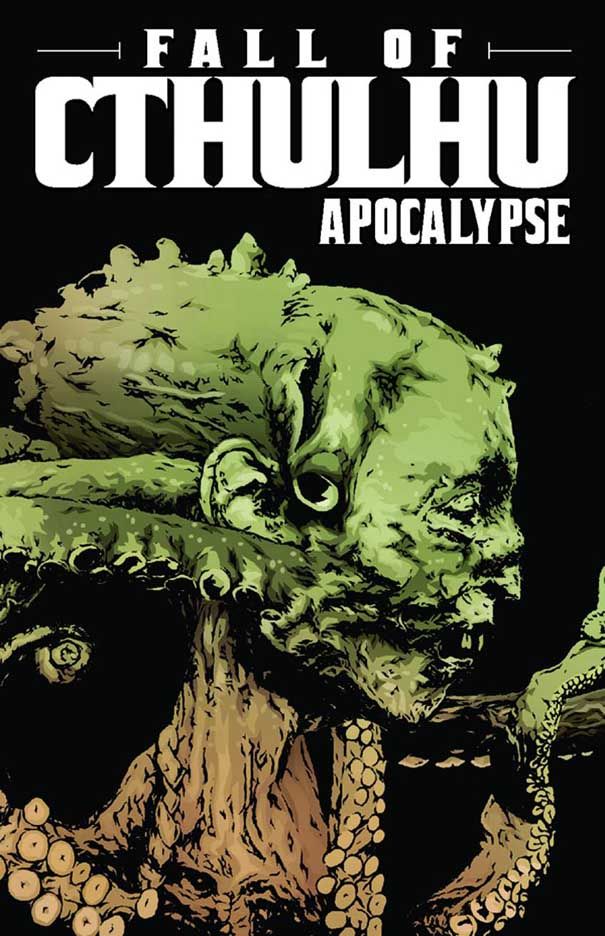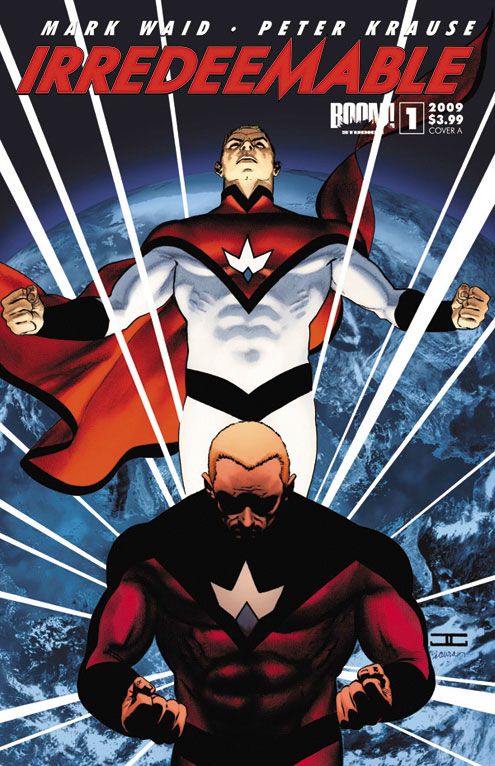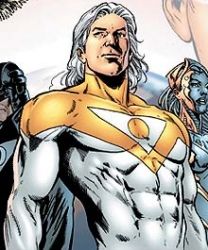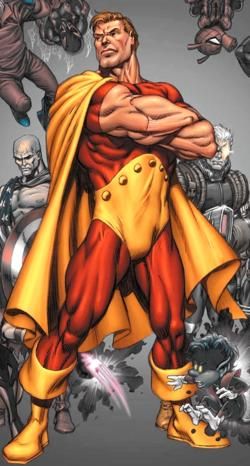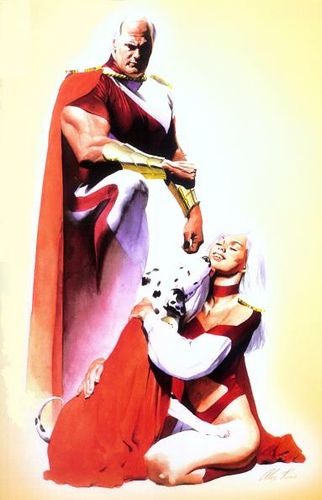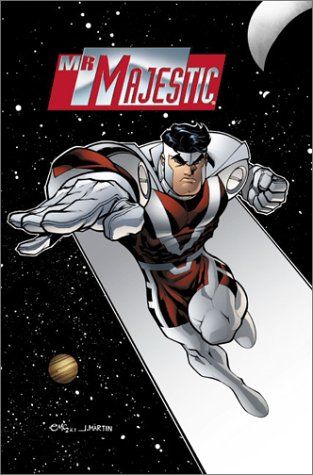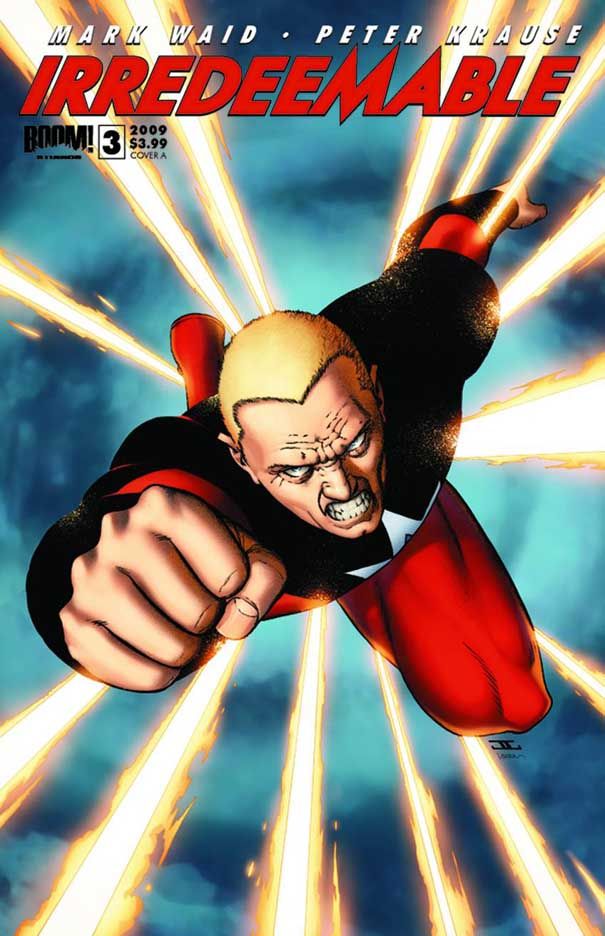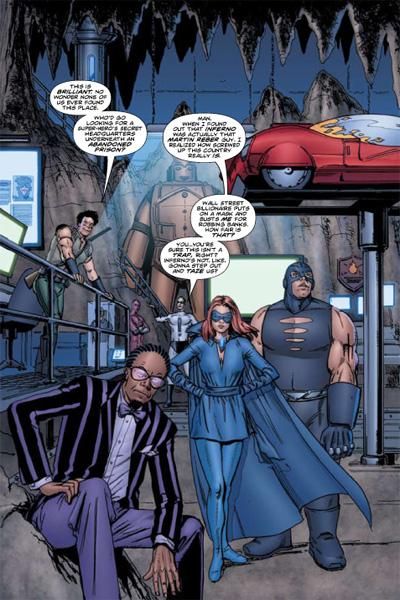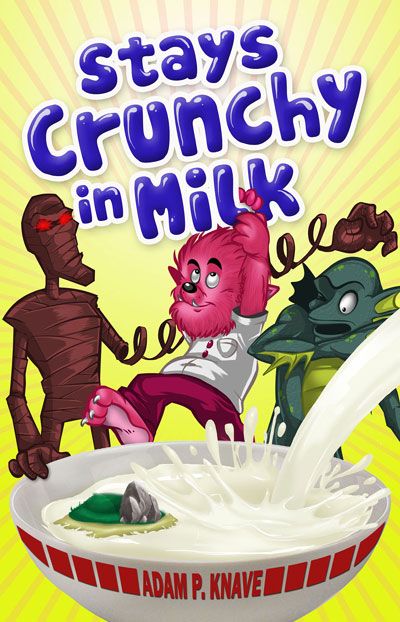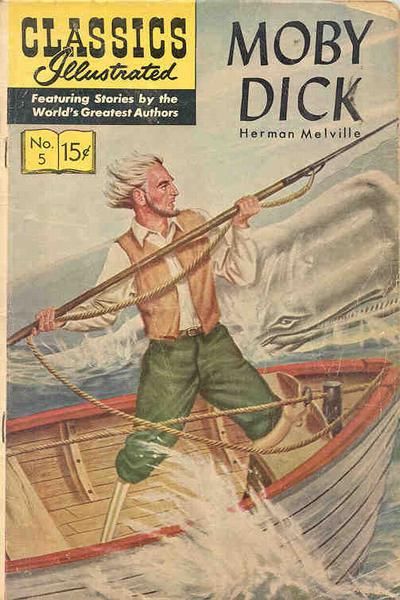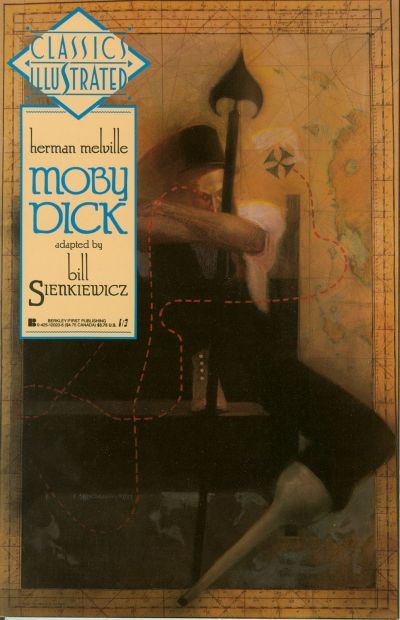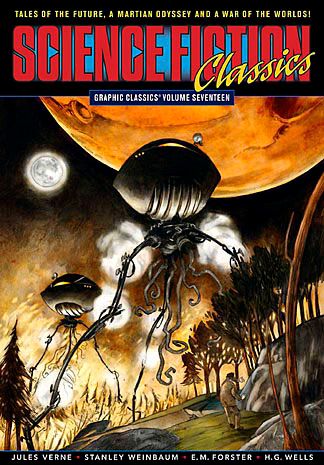Review copies of things I've promised to look at are piling up on me, so I'm going to by God get the decks cleared this week. A lot of these books and comics were actually a lot cooler than I thought they were going to be, so that was a nice surprise.
*
We are all on the BOOM! Studios review list, and Chip Mosher keeps us caught up with copies of what they're doing every week.
I certainly appreciate this, and I'm sure my colleagues on the blog do too. However, it does mean that we are in constant violation of our pledge in the sidebar to review everything that gets sent to us.
This always makes me feel absurdly guilty, even though I don't do reviews all that often. So my way of assuaging my guilt about not reviewing everything Chip sends us is to make a point of calling things to your attention that I think you will like, especially stuff that I'm not hearing a lot of buzz about.
All of which brings me to the remarkable series Fall of Cthulhu.
I've mentioned this series before, and even interviewed writer Michael Alan Nelson in this space a while back. Initially I was extremely skeptical about adapting H.P. Lovecraft to comics, but Mr. Nelson and a variety of talented artists proved it could be done and done well.
He did it by taking a long look at Lovecraft's original stories and then crafting a modern-day sequel that incorporates a lot of the original Cthulhu material -- the Necronomicon, Abdul Al-Hazred, the sunken city of R'lyeh -- and using it to tell a taut, modern mystery thriller. It's the best kind of pastiche, evoking the original while at the same time being very much its own thing.
When we did the interview, Nelson was just embarking on the arc that would become volume three, The Gray Man. At that time he told me that he had a plan for four major story arcs that would come together to form a complete saga with a defined beginning, middle, and end.
Well, the final part of that saga has now come out, and I sat down and read the whole thing through, start to finish, last weekend.
And I thought it was terrific. My only caveat is that it's clearly made up of four discrete story arcs, but it's published as five books: The Fugue, The Gathering, The Gray Man, Godwar, and Apocalypse. The last two in the sequence, Godwar and Apocalypse, are actually one story split across two books.
I can't really get too descriptive about them because I don't want to spoil anything, but I found them to be wonderfully entertaining adventure stories. The series is firmly rooted in the mythos that Lovecraft originally set up, but with the third installment, The Gray Man, the pace picks up considerably. The introduction of Arkham sheriff Raymond Dirk, along with the young Brazilian thief Lucy, as the series' protagonists really helps anchor the story and gives us an actual pair of heroes who find themselves caught in the crossfire between ancient entities who've been at war for centuries. It's still somewhat Lovecraftian in tone, but it reads more like The Bourne Identity filtered through a Dr. Strange kind of sensibility; an action movie with demons. It's a lot of fun and I really recommend it.
As usual with Boom! Studios output, the best way to read these is in trade paperback. My only grumble is that I think Godwar and Apocalypse belong in one volume, but a lot of companies are doing that volume one/volume two thing these days. And anyway, that's just presentation. It certainly didn't affect how much I enjoyed the story, which was a lot. You should check it out.
*
I see a fair amount of grousing around the net about Mark Waid's new superhero book, Irredeemable.
And to be honest I can see where at first glance it might seem to be a bit of a yawn. After all, it's not as though we've never seen a deconstructionist, adult-themed take on a Superman analogue before.
Sometimes I think in the late '90s and the early 2000s there was some sort of quota system requiring companies to publish comics featuring a Superman "homage."
So naturally the first impulse is to shrug and mutter, "Again with the Superman deconstruction?" Add to that the introduction in the first issue from Grant Morrison, which seemed designed as some sort of pre-emptive strike against internet snarking, and it starts to look like Boom! is practically setting the book up to be a fanboy piñata.
But there are a couple of things about Irredeemable that set it apart and make it worth checking out, at least for me.
First of all, it's really well-crafted. Mark Waid is probably one of the best writers of superhero comics out there, just in terms of his ability to construct a story. I am often annoyed with comics writers who can't seem to get started in under thirty or forty pages, and I am always impressed with Waid's ability to introduce the situation and characters, put across a conflict and provide, if not a resolution, at least a climactic moment of some kind, by the end of a single issue. I'd begun to think it was a lost art.
But more to the point, despite Grant Morrison's introduction complaining that fans shouldn't pigeonhole Mark Waid as "the Silver Age guy," to me Waid's Silver Age expertise is actually the book's great strength. Because I don't think there's anyone in comics who's put more thought into the character of Superman and what makes him unique and interesting and worth telling stories about than Waid. If you're going to do a story that deconstructs Superman and plays around with the idea of how if there really was such a being, the sheer insanity of his life would eventually destroy him and turn him evil... well, who do you get for that? Who's the guy that always gets brought up whenever it looks like it might be time to get a new writer on Superman? Duh.
In addition to chronicling the descent of the Superman-like Plutonian from universally-beloved hero to dark and merciless villain, though, Waid also brings a B-plot with a lot of other JLA analogues who have gone underground, trying to piece together a strategy to take the Plutonian down. There are lots of delightfully creepy little throwaway character bits, especially the extremely vile nastiness that opens issue #3. The whole book has a marvelous what-if vibe about it, that "story I always wondered about and never got to see" feeling.
If we can't have an actual Mark Waid Superman book, well, this will do for now. It reads like a companion piece to Kurt Busiek's Astro City, to be honest. So if you like that, I think you'll like this. Never mind all the grumbling about how "we've seen dark Superman before." Because, yeah, you have -- but you haven't seen it this well-thought-out before. It's early days yet, but I think this might eventually be something I'd rank with Miracleman if Waid can keep up the pace. In fact it is very reminiscent of Miracleman in its tone, but told from the viewpoint of Johnny Bates instead of Mike Moran, and with a more pop-culture sensibility.
I've been going on and on about Waid because at heart I'm a story guy, but I do like the art from Peter Krause very much. Solidly realistic superhero stuff, and again at first glance it looks pretty ordinary. But a closer look shows an amazing level of craftsmanship on display. I'm especially impressed with his faces; they're very well-differentiated, and the subtlety of the expressions and emotions he gives them really helps sell the story. I love the haggard look of the Lois analogue in #2, and the villains in #3 are wonderfully venal and opportunistic-looking without being caricatures.
Again, though, if money is an issue for you, I'd wait for the collected edition. $3.99 for a single issue, even one that's better-crafted and feels more complete than a lot of other singles these days, still seems like too much to me. Your mileage may vary. It's definitely worth checking out, though.
*
Something you always worry about, when you have friends who are in the arts, is when they ask you to look at their stuff. I worry about it, anyway. Because if it's bad, there's always that moment of awkward when you ask yourself whether you should level with them or spare their feelings.
And that discomfort is multiplied a thousandfold when you are writing a column and friends send you review copies of things they've done.
So when my old friend Adam Knave sent along a review copy of his new novel I choked out something like "I'll look at it, sure, but no promises." My usual out in these cases is that if the work turns out to be awful, I won't write anything at all, rather than pan it. I wouldn't ever recommend a book I thought was bad, not even for a pal. But I won't kneecap a buddy by beating up on his book in public, either, because I know how hard it is to write one and get it in print even if it turns out sucky.
Thankfully, I don't need to do that in this case because I really rather liked Adam's book.
Stays Crunchy in Milk is a story that defies easy categorization. It's a sort of allegory and a sort of satire and a sort of quest-adventure fairytale, and it could only be the product of someone as immersed in pop culture as I know Adam to be.
The plot is simple enough -- Wereberry the strawberry werewolf, Choco-Ra the chocolate mummy, and the Creature From the Fruit Lagoon are traveling across a magical land in search of their missing friend, Cherrygeist. But there's a lot more going on than that.
Now, I have to be honest. The story of a bunch of cereal mascots traveling across a land peppered with Saturday morning cartoon and commercial analogues certainly sounds too precious and self-referential for words, and I put off looking at the book for weeks in a fit of cringing cowardice that I would hate it and be forced to somehow break it to Adam that I thought his book was horrible. So I was surprised and delighted to find that the novel is actually terrifically engaging and charming and not at all snarky. It is, in fact, really very uplifting, a story of hope and friendship and loyalty.
All in all, it's a remarkable piece of work, I am relieved and happy to say, and I recommend it with a clear conscience to all of you, whether you're old enough to remember Count Chocula or not. It's coming out from Creative Guy Publishing in August. Watch for it.
*
Classics Illustrated is a comic book idea that keeps cropping up. When I was a youngster, they were a ubiquitous presence in doctors' and dentists' waiting rooms, along with Golden Magazine and Highlights.
Then, in the '90s, First Comics revived the line with new, prestige-format comics adaptations from a variety of star artists.
It never really caught fire that time out, and I thought that was a shame. I teach comics in school myself, and I thought First really missed a bet by not pushing their Classics line a lot harder with schools and libraries. That was where the original Classics Illustrated did most of their business, after all, and today educators are far more receptive to comics than when I was growing up. But in the direct comics market, you couldn't give the things away.
Anyway, whatever the reason, it didn't really take off and I assumed the idea of adapting classic literary works to comics was done. Classics Illustrated was relegated to a nostalgia thing for funnybook scholars.
Until I got a press release from Tom Pomplun at Graphic Classics asking if I wanted an advance copy of their latest release, Science Fiction Classics.
It's volume seventeen of their line and the first to be printed in color. The interesting thing about this particular riff on the old Classics Illustrated idea is that for once, someone has recognized that you can't really boil down a huge lit'ry novel to a 23-page comic book, or even to a 56-page one. However, you can do very well by concentrating on short stories and novellas, and that's what Graphic Classics is doing. Here's the lineup for this graphic novel--
• "The War of the Worlds" by H.G. Wells, adapted by Rich Rainey and illustrated by Micah Farritor
• "In the Year 2889" by Jules Verne, adapted by Tom Pomplun, illustrated by Johnny Ryan
• "A Martian Odyssey" by Stanley G. Weinbaum, adapted by Ben Avery and illustrated by George Sellas
• "The Machine Stops" by E.M. Forster, adapted by Tom Pomplun and illustrated by Ellen Lindner
• "The Disintegration Machine" by Arthur Conan Doyle (starring Professor Challenger of "The Lost World") adapted by Rod Lott and illustrated by Roger Langridge
• "The Bureau d’Echange de Maux" by Lord Dunsany, adapted by Antonella Caputo and illustrated by Brad Teare
• Plus a short-short by Hans Christian Andersen, illustrated by Hunt Emerson
That's a heaping helping of classic SF, and I really like the varying art styles, especially since so many of the artists are names that are new to me. I thought it was -- you should pardon the expression -- a very classy package.
But the real make-or-break question for me was, would this be an attractive package for young people? Enough to be useful as a "gateway" book for teachers and librarians? I decided to test it empirically, and took it to my middle-school Cartooning class.
Several of the boys were interested. Anton took one look at the cover and lunged at it. I told him if he wrote me a real review, he could have the book to take home.
Anton paused and looked up at me, stonkered. He clearly was lusting for the book, but he hates writing -- actually, he hates working, period -- and was struggling a bit with the concept of a review. "Like a book report?" he asked me, suspiciously.
"Well, a little. But less formal," I told him. "Think of what you would answer if a friend asked you about it. Did you like it? What parts did you like? Would you buy it? Write down your answers to those questions and you'll have it."
Anton nodded and scampered back to his table, and half an hour later presented me with a scrawled one-page review.
Here is what he had to say:
Science Fiction Classics is a very good, exciting adventure book. There are six classics in the book. Also the art is very good, I should say, it is cool. That is why you should buy it. Your friend, Anton.
So there you have it. If it got a student as reluctant to work as Anton to actually volunteer to write real words on paper, then Mr. Pomplun and company might really have something.
The Graphic Classics web site, with the listing of their complete catalogue, is here. I think you get a better deal if you order direct from them.
*
...and that clears the "In" box completely, I think. At least it does mine. Thanks to all of you who send stuff, we appreciate your patience. We do eventually get to everyone. At least we try to.
See you next week.



